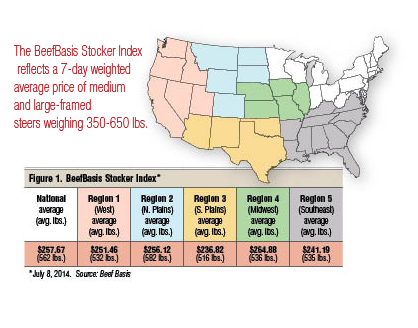New Stocker Index Prices Stocker Calves More Precisely
New stocker index offers real-time prices by region.
July 29, 2014

Determining the value of calves to buy and sell is never an exact science. And it’s become tougher, given the sweeping price variations between geographic regions and weight classes week to week, and the sheer price level of all cattle.
All this drove development of the BeefBasis Stocker Index (BBSI), which offers buyers and sellers a more precise look at what calves are worth in their locale at any given time.
“The Stocker Index, like the CME Feeder Cattle Index, is a price discovery tool,” explains Brett Crosby, a partner in Custom Ag Solutions (CAS).
Unlike the CME Feeder Cattle Index, which reflects a 7-day weighted average for medium and large No. 1 and medium and large No. 1-No. 2 steers weighing 650-850 lbs., the BBSI documents the value of lighterweight cattle nationally and by region.
Subscribe now to Cow-Calf Weekly to get the latest industry research and information in your inbox every Friday!
“It’s probably most useful for cow-calf operators who sell calves weighing 450-650 lbs., and/or stocker operators looking to replace their inventory on grass,” Crosby says.
Specifically, the BBSI reflects a 7-day weighted average price of medium and large-framed steers weighing 350-650 lbs. Prices are gathered from USDA auction reports. If you went to beefbasis.com on July 8, you would have seen the BBSI — the national average — was $257.67/cwt. on an average weight of 562 lbs. More importantly, you’d also have learned that regional indices (Figure 1) ranged from $236.82 in the Southern Plains (516 lbs.) to $264.88 in the Midwest (536 lbs.).
That’s a $28.06/cwt. difference on a single day for similar-weight calves. You’d also have found a national value of gain (VG). “VG represents the current difference in value between lighter calves and heavier calves,” Crosby explains. Essentially, it tells you the worth of an additional 100 lbs. that day.
For instance, using the index value in the Southern Plains of $236.82, the national VG on the same day was $146.10/cwt. That’s what an additional 100 lbs. to the base average weight would have been worth at auction in that region at that time. It offers sellers an indication of how much keeping calves and adding weight would be worth. It also provides buyers an idea of the relative opportunity to add weight to lighter or heavier cattle.
CAS developed the BBSI last fall in cooperation with Kansas State University agricultural economists Glynn Tonsor and Kevin Dhuyvetter (the latter is now with Elanco). Among other things, CAS provides clients with technical services related to data collection, analysis and reporting.
Incidentally, beefbasis.com offers a number of free tools in addition to the Stocker Index: everything from local basis to ration and cost calculators.
“The impetus for development was volatile price slides for lightweight calves and significant regional differences in lightweight calf prices,” Crosby emphasizes. “We were looking for a way to give producers a better look at what the lightweight calf market was doing in their specific region.”
Other popular articles at BEEF:
70+ Photos Honor The Hardworking Cowboys On The Ranch
Just How High Can This Market Go?
How To Treat Lump Jaw Disease In Cattle
8 Biggest Roadblocks to Ranch Profitability
Virtual Tour: Visit The World's Largest Vertically Integrated Cattle Operation
10 Signs You Grew Up On A Farm
About the Author(s)
You May Also Like




.png?width=300&auto=webp&quality=80&disable=upscale)
